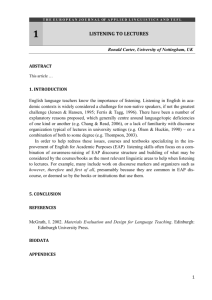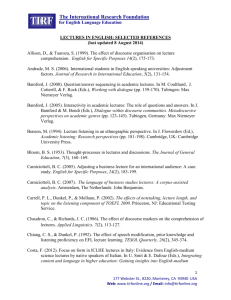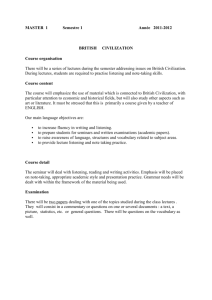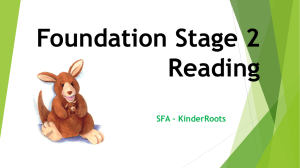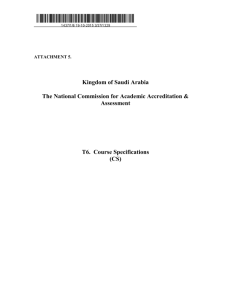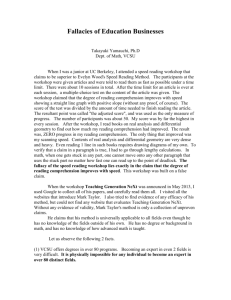The International Research Foundation
advertisement
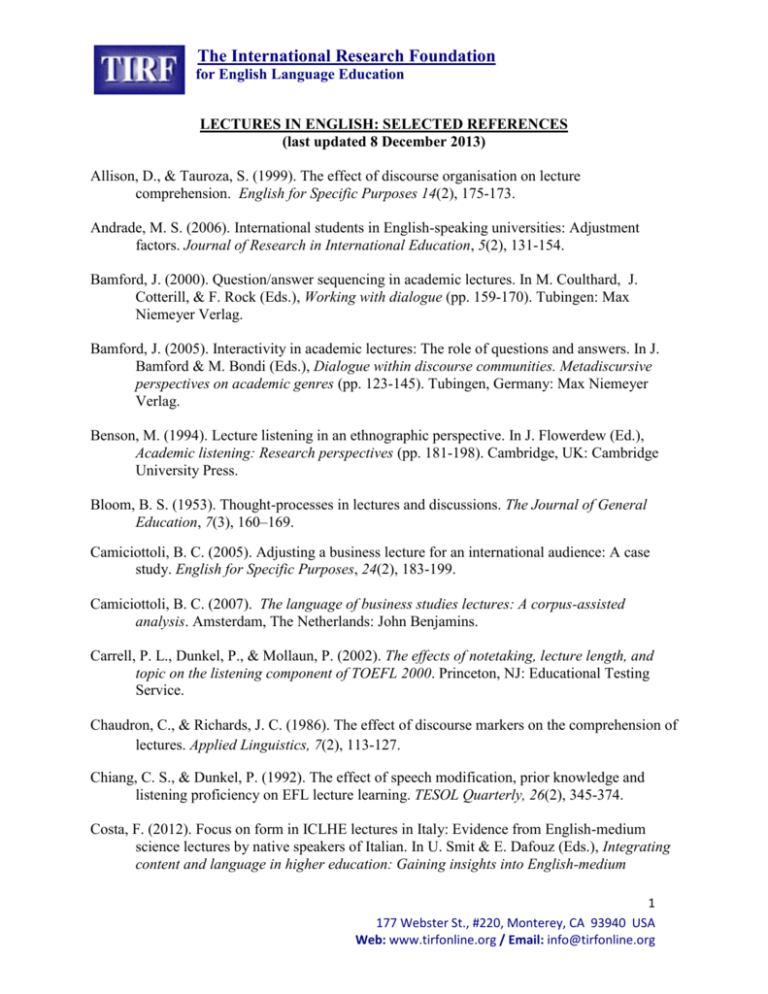
The International Research Foundation for English Language Education LECTURES IN ENGLISH: SELECTED REFERENCES (last updated 8 December 2013) Allison, D., & Tauroza, S. (1999). The effect of discourse organisation on lecture comprehension. English for Specific Purposes 14(2), 175-173. Andrade, M. S. (2006). International students in English-speaking universities: Adjustment factors. Journal of Research in International Education, 5(2), 131-154. Bamford, J. (2000). Question/answer sequencing in academic lectures. In M. Coulthard, J. Cotterill, & F. Rock (Eds.), Working with dialogue (pp. 159-170). Tubingen: Max Niemeyer Verlag. Bamford, J. (2005). Interactivity in academic lectures: The role of questions and answers. In J. Bamford & M. Bondi (Eds.), Dialogue within discourse communities. Metadiscursive perspectives on academic genres (pp. 123-145). Tubingen, Germany: Max Niemeyer Verlag. Benson, M. (1994). Lecture listening in an ethnographic perspective. In J. Flowerdew (Ed.), Academic listening: Research perspectives (pp. 181-198). Cambridge, UK: Cambridge University Press. Bloom, B. S. (1953). Thought-processes in lectures and discussions. The Journal of General Education, 7(3), 160–169. Camiciottoli, B. C. (2005). Adjusting a business lecture for an international audience: A case study. English for Specific Purposes, 24(2), 183-199. Camiciottoli, B. C. (2007). The language of business studies lectures: A corpus-assisted analysis. Amsterdam, The Netherlands: John Benjamins. Carrell, P. L., Dunkel, P., & Mollaun, P. (2002). The effects of notetaking, lecture length, and topic on the listening component of TOEFL 2000. Princeton, NJ: Educational Testing Service. Chaudron, C., & Richards, J. C. (1986). The effect of discourse markers on the comprehension of lectures. Applied Linguistics, 7(2), 113-127. Chiang, C. S., & Dunkel, P. (1992). The effect of speech modification, prior knowledge and listening proficiency on EFL lecture learning. TESOL Quarterly, 26(2), 345-374. Costa, F. (2012). Focus on form in ICLHE lectures in Italy: Evidence from English-medium science lectures by native speakers of Italian. In U. Smit & E. Dafouz (Eds.), Integrating content and language in higher education: Gaining insights into English-medium 1 177 Webster St., #220, Monterey, CA 93940 USA Web: www.tirfonline.org / Email: info@tirfonline.org The International Research Foundation for English Language Education instruction at European universities (AILA, 25) (pp. 30-47). Philadelphia, PA: John Benjamins. Crawford Camiciottoli, B. (2004). Interactive discourse structuring in L2 guest lectures: Some insights from a comparative corpus-based study. Journal of English for Academic Purposes, 3(1), 39-54. Crawford Camiciottoli, B. (2005). Adjusting a business lecture for an international audience: A case study. English for Specific Purposes, 24, 183-199. Csomay, E. (2002). Variation in academic lectures. In R. Reppen, S. M. Fitzmaurice, & D. Biber (Eds.), Using corpora to explore linguistic variation (pp. 203-224). Philadelphia, PA: John Benjamins. DeCarrico, J., & Nattinger, J. R. (1988). Lexical phrases for the comprehension of academic lectures. English for Specific Purposes, 7(2), 91-102. Dudley-Evans, T. (1994). Variations in the discourse patterns favoured by different disciplines and their pedagogical implications. In J. Flowerdew (Ed.), Academic listening: Research perspectives, (pp. 146-158). Cambridge, UK: Cambridge University Press. Dunkel, P. (1988). The content of L1 and L2 students’ lecture notes and its relationship to test performance. TESOL Quarterly 22(2), 259-281. Dunkel, P. A., & Davis, J. N. (1994). The effects of rhetorical signaling cues on the recall of English lecture information by speakers of English as a native or second language. In J. Flowerdew (Ed.), Academic listening: Research perspectives (pp. 55-74). Cambridge, UK: Cambridge University Press. Ferris, D., & Tagg, T. (1996). Academic listening/speaking tasks for ESL students: Problems, suggestions, and implications. TESOL Quarterly, 30(2), 297-320 Flowerdew, J. (1994). Research of relevance to second language lecture comprehension: an overview. In J. Flowerdew (Ed.). Academic listening: Research perspectives (pp. 9-23). Cambridge, UK: Cambridge University Press. Flowerdew, J. (Ed.). (1994). Academic listening: Research perspectives. Cambridge, UK: Cambridge University Press. Flowerdew, J., & Miller, L. (1997). The teaching of academic listening comprehension and the question of authenticity. English for Specific Purposes, 16(1), 27-46. Flowerdew, J., & Tauroza, S. (1995). The effect of discourse markers on second language lecture comprehension. Studies in Second Language Acquisition, 17, 435-458. 2 177 Webster St., #220, Monterey, CA 93940 USA Web: www.tirfonline.org / Email: info@tirfonline.org The International Research Foundation for English Language Education Fortanet Gomez, I. (2004). The use of ‘we’ in university lectures: Reference and function. English for Specific Purposes, 23(1), 45-66. Fortanet, I. (2004). Enhancing the speaker-audience relationship in academic lectures. In P. Garcés-Conejos, M. Padilla, R. Gómez, & L. Fernández (Eds.), Current trends in intercultural, cognitive and social pragmatics (pp. 83-96). Seville: Editorial Kronos. Fortanet, I., Palmer, J. C., & Ruiz, M. F. (2007). Interaction through shared knowledge in American, British, and Spanish business lectures. In P. Garcés-Conejos, M. Padilla, R. Gómez, & L. Fernández (Eds.), Studies in intercultural, cognitive and social pragmatics (pp. 93-110). Newcastle, UK: Cambridge Scholars Publishing. Hansen, C., & Jensen, C. (1994). Evaluating lecture comprehension. In J. Flowerdew (Ed.), Academic listening: Research perspectives (pp. 241-268). Cambridge, UK: Cambridge University Press. Hellekjær, G. O. (2010). Assessing lecture comprehension in Norwegian English-medium higher education. Language use and language learning in CLIL classrooms, 7, 233. Hellekjaer, G. O. (2010). Lecture comprehension in English-Medium higher education. Hermes– Journal of Language and Communication Studies, 45, 11-34. Hauge, T. (2011). Language excellence - a necessary skill? University lecturers’ dilemmas in teaching content courses in English as an international language. In R. Cancino, L. Dam & K. Jæger (Eds.), Policies, principles, practices: New directions in foreign language education in the era of educational globalization (pp. 161-187). Newcastle upon Tyne, UK: Cambridge Scholars Publishing. Kanaoka, Y. (2009). Academic listening encounters. New York, NY: Cambridge University Press. Khuwaileh, A. A. (1999). The role of chunks, phrases and body language in understanding coordinated academic lectures. System, 27(2), 249-260. Lebauer, R. (1984). Using lecture transcripts in EAP lecture comprehension courses. TESOL Quarterly, 18(1), 41-54. Lynch, T. (2006). Academic listening: Marrying top and bottom. In E. Usó-Juan & A. MartínezFlor (Eds.), Current trends in learning and teaching the four skills within a communicative framework (pp. 91-110). The Hague, The Netherlands: Mouton de Gruyter. Mendelsohn, D. (2002). The Lecture Buddy project: An experiment in EAP listening comprehension. TESL Canada Journal, 20, 64-73. 3 177 Webster St., #220, Monterey, CA 93940 USA Web: www.tirfonline.org / Email: info@tirfonline.org The International Research Foundation for English Language Education Miller, L. (2002). Towards a model for lecturing in a second language. Journal of English for Academic Purposes, 1(2), 145-162. Morell , T. (2004). Interactive lecture discourse for university EFL students. English for Specific Purposes, 23, 325-338. Morell, T. (2007). What enhances EFL students’ participation in lecture discourse? Student, lecturer and discourse perspectives. Journal of English for Academic Purposes, 6, 222237. Mulligan , D., & Kirkpatrick , A. (2000). How much do they understand? Lectures, students and comprehension. Higher Education Research and Development, 19(3), 311-335. Murphy, D. F., & Candlin, C. N. (1979). Engineering lecture discourse and listening comprehension. Practical Papers in English Language Education, 2, 1-79. Nesi, H. (2001). A corpus based analysis of academic lectures across disciplines. In J. Cotterill & A. Ife (Eds.), Language across boundaries (pp. 201-218). London, UK: Continuum Press. Olsen, L. A., & Huckin, T. H. (1990). Point-driven understanding in engineering lecture comprehension. English for Specific Purposes, 9(1), 33-47. Penner, J. G. (1992). Why many college teachers cannot lecture. Springfield, IL: Charles C. Thomas. Rost, M. (1994). On-line summaries as representations of lecture understanding. In J. Flowerdew (Ed.), Academic listening: Research perspectives (pp. 93-127). Cambridge, UK: Cambridge University Press. Salahzadeh, J. (2005). Academic listening strategies: A guide to understanding lectures. Ann Arbor, MI: University of Michigan Press. Strauss, P. (2002). The lecturer doesn't have a rewind button–addressing the listening difficulties of mainstream L2 students at a New Zealand university. Journal for Language Teaching, 36(1-2), 91-104. Strodt-Lopez, B. (1991). Tying it all in: Asides in university lectures. Applied Linguistics, 12(2), 117-140. Tauroza, S., & Allison, D. (1994). Expectation-driven understanding in information systems lecture comprehension. In J. Flowerdew (Ed.), Academic listening: Research perspectives (pp. 35-54).Cambridge, UK: Cambridge University Press. 4 177 Webster St., #220, Monterey, CA 93940 USA Web: www.tirfonline.org / Email: info@tirfonline.org The International Research Foundation for English Language Education Thompson, S. (1994). Frameworks and contexts: A genre-based approach to analyzing lecture introductions. English for Specific Purposes, 13(2), 171-186. Thompson, S. E. (2003). Text-structuring metadiscourse, intonation and the signaling of organisation in academic lectures. Journal of English for Academic Purposes, 2(1), 5-20. Wennerstrom, A. (1998). Intonation as cohesion in academic discourse. Studies in Second Language Acquisition, 20(1), 1-25. 5 177 Webster St., #220, Monterey, CA 93940 USA Web: www.tirfonline.org / Email: info@tirfonline.org
